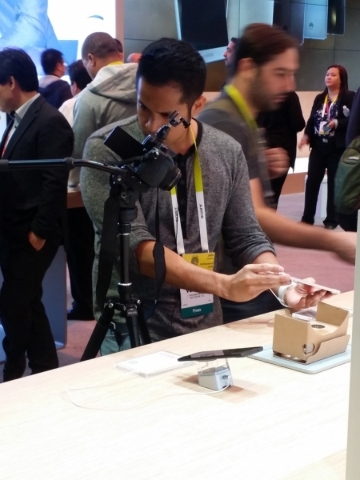Post-scarcity economy good for tech fans
Tired of ironing your clothes? Then perhaps you would be interested in buying the $1,600 ironing machine from electronics maker LG, now at CES, where clothes hang in a refrigerator-looking rectangle, swaying away wrinkles and germs.
Not your cup of $1,600 tea? How about a $40 blank hat with a little hole in the middle where a high-definition surveillance camera keeps an eye on ... whom? Who do you need to surveil?
CES is known for many things. Cars. Phones. TVs. But the periphery is full of these odd and interesting peripherals that speak volumes about ourselves and our new economy.
Yes, the new economy is not like what baby boomers and Gen-Xers were taught in school. We no longer live in a strictly supply-and-demand world, where a company says, "We decide how much of a thing we're going to give you, and you shall pay."
Because of the Internet's explosion of individual entrepreneurs, and things such as same-day delivery of goods door-to-door, we now live in a post-scarcity economy.
That is, nothing is scarce, everything is abundant, and the result is more and more and more stuff.
I'm happy about this, most days. Most people seem to be.
But will there come a reckoning?
At the end of Wednesday at CES, I ran into Sagar Malviya of the Economic Times of India, the world's second-largest business newspaper.
He wasn't keen on that ironing machine.
"All it does is irons and sanitation," Malviya said. "Half of the technology (at CES), I don't find it relevant for day-to-day use."
He's concerned how our post-scarcity economy will play out.
"In India, we used to save a lot. Now, youngsters don't really save," Malviya, 35, said. "They take risks. That's good for business.
"But they don't need to actually wait for anything. They don't have to work hard for anything. So I think it's bad for the economy," he said. "Right now, it's a shotgun economy. It's a two-minute-noodle economy. Everybody wants everything quickly."
Let me give you a good example of our consumer culture. I interview celebrities for a living, no big whoop, but I saw someone at the Nexus 6p counter who jolted me, John Velasco, who writes reviews and stars in videos for PhoneArena.com, which I read daily like a maniac.
Velasco, known as John V., is a tech celebrity. We have tech celebrities, because of all the stuff we buy.
Velasco and I talked about how everything in mobile phones and tablets and watches is all incremental progress.
"Every year, there are bigger displays, higher resolutions, and faster processors," he said.
"But the real long-term stuff is, like, 'When are we going to see one-week battery life (for phones)? When are we going to see really cool innovations like the flexible OLED displays they're talking about, where a 5-inch smartphone can become a 10-inch tablet just because you fold it over?"
So people like me read sites like PhoneArena every day, pouring over as many as 40 posts a day, even though I haven't bought new tech in months while waiting for long-term innovation. I asked him: Isn't that weird?
"You get jaded, I guess. That's how I feel," he said with a Samsung Gear 2 watch on his left wrist (it makes calls and texts) and a badass LG V10 phone in his pocket. "You get so much information (and) you're just waiting for a very incremental handset" progress in a new phone.
Jaded or not, John V. and I can't stop being excited by the tech age, because it's the thing changing the world faster than everything.
"I don't call it a job. I don't call it work," he said. "I call it passion. It's something you wake up every day and look forward to."
Ask a Millennial like Jeremy Hernandez, 24, about tech-optimism. This is his fifth CES. He started doing press on gaming at age 20, with a Vegas-based YouTube channel netting 5,000 subscribers.
He has no cable TV.
"Netflix is pretty much the only thing people use. It's cheaper. It's 10 bucks a month," Hernandez, who now has a production and photography business, said.
On Wednesday, he took a CES gig showing people how to use a 20-pound camera rig for a movie-capable camera-steadying device called a Steadicam Steadimate. People stared in wonder.
Where Malviya sees worry with tech, Hernandez sees hope, as tech companies improve access to health care, art, information, and so much more, thanks largely to phones that are getting so small, "sooner or later, it will be so thin, it'll be in your ear," he said.
"A lot better days" appear ahead, Hernandez said.
Keep your digital fingers crossed.
Doug Elfman can be reached at delfman@reviewjournal.com. He blogs at reviewjournal.com/elfman. On Twitter: @VegasAnonymous.

































